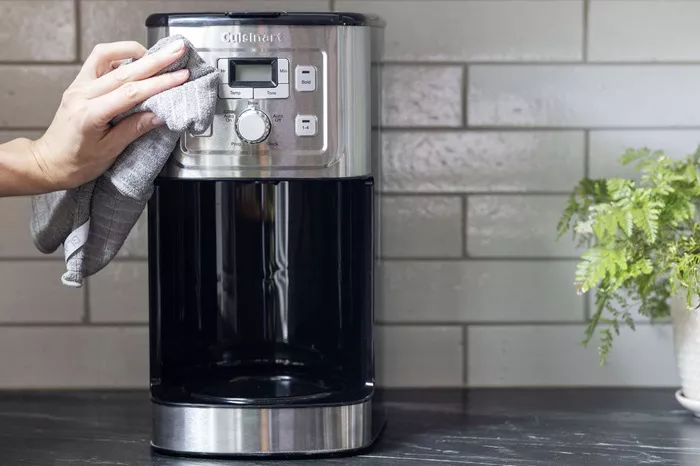A clean coffee maker is the key to brewing fresh, flavorful coffee every morning. Over time, mineral buildup, coffee oils, and bacteria can accumulate in your Cuisinart coffee maker, affecting both the taste of your coffee and the machine’s performance. Regular cleaning with a simple household item like vinegar is an effective and eco-friendly way to keep your coffee maker in top shape. In this guide, we will walk you through the complete process of cleaning your Cuisinart coffee maker with vinegar, step by step.
Benefits of Cleaning with Vinegar
Removes Mineral Deposits and Coffee Residue
Tap water often contains minerals like calcium and magnesium. These minerals can build up inside your coffee maker’s internal components, especially in the heating element and water reservoir. Vinegar, which contains acetic acid, is excellent at breaking down these deposits. It also helps dissolve coffee oils and leftover residue that stick to the machine after repeated use.
Eliminates Bacteria and Mold
Coffee makers provide a warm, moist environment that can harbor bacteria, mold, and yeast. Vinegar is naturally antibacterial and antifungal. Cleaning with vinegar helps sanitize your coffee maker, making each cup of coffee safer to drink.
Affordable and Eco-Friendly
Vinegar is inexpensive and easy to find in any grocery store. Unlike harsh chemical cleaners, vinegar is safe for the environment and doesn’t introduce toxins into your home. It’s a natural solution that effectively cleans without harmful residues.
Preparation
Before you begin cleaning your Cuisinart coffee maker, gather the following items:
- White distilled vinegar
- Fresh water
- A cleaning brush or toothbrush
- Mild dish soap
- A soft cloth or sponge
Safety First
Unplug the coffee maker. Always unplug the machine before cleaning to avoid electrical shock.
Empty the machine. Remove any used coffee grounds, paper filters, or reusable mesh filters.
Let it cool. If you recently brewed coffee, allow the machine to cool completely before cleaning.
Step-by-Step Cleaning Process
Step 1: Mix Vinegar and Water
Fill the coffee maker’s water reservoir with a mixture of equal parts white vinegar and fresh water. For example, if your reservoir holds 12 cups, mix 6 cups of vinegar with 6 cups of water.
Step 2: Run a Brewing Cycle
Place the carafe in position.
Start a regular brew cycle. Allow the machine to run until about halfway through the cycle, then pause it. This lets the vinegar sit inside the machine and break down any buildup.
Let the machine sit for 30 to 60 minutes.
After the pause, resume the brewing cycle and let it complete.
Step 3: Discard the Solution
Once the brewing cycle is done, pour out the vinegar solution from the carafe.
Rinse the carafe thoroughly with fresh water.
Step 4: Run Fresh Water Rinse Cycles
Fill the reservoir with clean water only.
Run a full brew cycle.
Repeat this process 2 to 3 times to ensure all vinegar is flushed out of the system.
Tip: If you still smell vinegar after the second rinse, do a third cycle with fresh water.
Maintenance Tips
Clean External Parts
Carafe: Wash the glass carafe with warm soapy water and a soft sponge. Avoid using abrasive pads that can scratch the surface.
Filter basket: Remove and wash the filter basket with mild dish soap. You can use a small brush or toothbrush to clean hard-to-reach areas.
Lid and exterior: Wipe down the exterior of the coffee maker with a damp cloth. For buttons or grooves, use a soft brush.
Descale Regularly
If you live in an area with hard water, you may notice more frequent buildup. In that case, clean your coffee maker every 1–2 months.
For areas with soft water, every 3–6 months is usually enough.
Some Cuisinart models have a “clean” indicator light that will alert you when it’s time to descale.
Safety Precautions
Handle with Care
Always allow the machine to cool before handling any internal parts or starting the cleaning process.
Be cautious with hot water or steam during rinsing cycles.
Rinse Thoroughly
It is important to rinse the machine multiple times with fresh water after cleaning with vinegar. Leftover vinegar can alter the taste of your coffee and may be unpleasant.
Never use bleach or other harsh chemicals. These can damage the internal parts and are not safe for consumption.
Conclusion
Keeping your Cuisinart coffee maker clean is essential for maintaining the quality and flavor of your coffee. Vinegar is an affordable, effective, and environmentally friendly way to descale and disinfect your machine. By following the simple steps above, you’ll remove mineral deposits, eliminate bacteria, and help your coffee maker last longer.
Regular cleaning every few months (or more often if you have hard water) will ensure that your coffee always tastes fresh and your machine works efficiently. So grab that bottle of vinegar and give your Cuisinart the care it deserves—it’ll thank you with better coffee.
Enjoy your next cup!
Related topics:
- How to Use Espresso Maker on Stove
- What Are Oily Coffee Beans?
- How Much Caffeine in Rise Nitro Cold Brew


